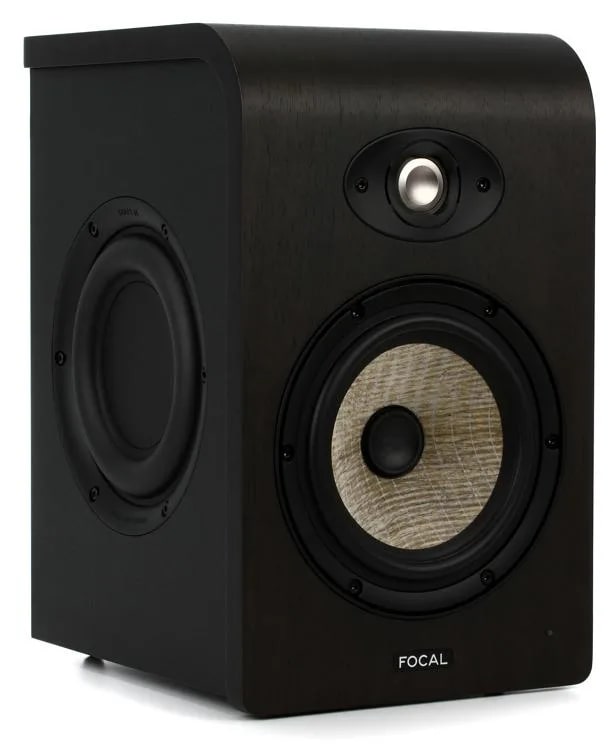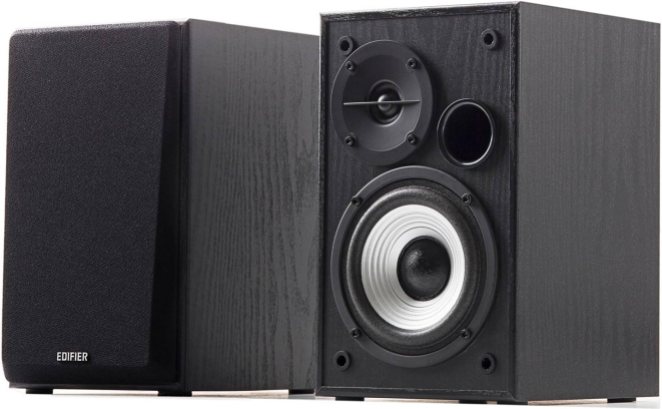When you buy through our links, we may earn an affiliate commission.
In consumer and professional audio speakers and reference monitors come in two primary categories - active speakers and passive speakers.
Unlike passive speakers, active speakers have an amplifier built into the speaker hardware. Passive speakers are the opposite and require an external power amplifier to function.
The terms active and powered speakers are often used interchangeably, and while they're similar, they're not quite the same thing (more on that later).
Though it comes in at a high price point, our top pick for best powered speakers is the KEF LS50. This is because of KEF's proprietary sound engine, high-grade audio resolution, and powerful built-in amplifiers pumping each driver.
If you don’t need a model that’s quite sophisticated, the Triangle Audio AI0 Twin is a great runner-up option. It offers a variety of input standards, optional subwoofer output for deep bass, and full frequency range.
Let's examine some of our favorite active speakers that cover a variety of categories and use, features to look for, and some common questions on the topic.
Quick Summary of the Best Active Speakers
- KEF LS50 (Best Overall)
- Triangle Audio AI0 Twin (Best All-Around)
- Focal Shape 65 (Best Active Studio Reference Monitors)
- Edifier R1280DB (Best Bookshelf Speakers)
- Fluance Ai61 (Best Mid-Priced)
- Kanto YU2MW (Best Compact Model)
- Edifier R980T (Best for Computer Use)
Best Active Speakers
1. Best Overall – KEF LS50

SPECS
- Inputs: Auxiliary, Wi-Fi, digital coaxial, RJ45, TOSLINK, HDMI eArc
- Outputs: Subwoofer
- Frequency Range: 40Hz to 47kHz
What the KEF LS50 model can do is truly impressive. Powered by their proprietary Music Integrity Engine digital signal processing, the timing and imaging of the signal are flawlessly focused.
The best-in-class 24-bit/384kHz sound resolution provides an unparalleled level of detail that provides the great sound you'd expect from a model in this price range.
Each speaker has a built-in 280-watt mid-range amplifier and 100-watt tweeter to cover the high end. They feature Metamaterial Absorption Technology, a complex pattern that is designed to absorb unwanted resonances that emanate from the rear of the drivers. This eliminates distortion and gives a tighter, more focused sound.
It offers wireless streaming and HDMI arc port connectivity options that can play Spotify, Tidal, Amazon Music, Deezer, Chromecast, Apple AirPlay 2, ROON, and more.
They can network through a variety of MQA and DSD standards. And through the Connect app, you can remotely control playback, transport, and equalization.
The high-end sound quality of these all-in-one powered speakers makes them the perfect sound hub for music, movies, gaming, streaming, and more. The LS50 is by no means inexpensive. At $2,800, it is clearly made for only the most sound-serious audiophiles, and they sound like it.
2. Best All-Around – Triangle Audio AI0 Twin

SPECS
- Inputs: RCA/phono, auxiliary, optical-SPDIF, Bluetooth, USB
- Outputs: Optional connection to Tales 340 subwoofer
- Frequency Range: 56Hz to 22kHz
If you’re looking for an active speaker pair that has a solid all-around feature set, the Triangle Audio AIO model is one of the best.
Connectivity options are one of the biggest selling points of the AIOs. You can connect it to virtually any audio source through the various standards, including an optical input.
Through the 3.5mm auxiliary phono input, you can integrate them into your home stereo sound system, car, or computer desktop system.
You can send a high-resolution streaming feed at 24-bit/192kHz from your tablet, smartphone, or computer via universal Bluetooth connectivity or link up the wireless connectivity for streaming.
Through Triangle’s Linkplay technology, you can network all of their devices and monitor them simultaneously. This gives you control over playback controls, sound level, and EQ optimization directly from the app.
Aesthetically they’re as sleek as the I/O and sound features they offer. You can select between six different colors, including a very elegant faux brown maple. Regardless of your color choice, they complement the vibe of any listening environment.
They don’t take up much space, but at 50W, they can move a lot of air. The price point won’t suit everyone, but if you are looking to invest in a versatile pair of active speakers that sound as good as they look, these are one of the best options.
3. Best Active Studio Reference Monitors – Focal Shape 65

SPECS
- Inputs: XLR, RCA
- Outputs: N/A
- Frequency Range: 40Hz to 35kHz
Focal has really created some buzz (the good kind!) in the pro audio industry in recent years for its forward-thinking studio monitor designs. These near-field monitors are a great asset to any music or sound design studio setup, with XLR and RCA analog inputs.
Through the TMD surround build element, you get a neutral midrange that isn’t hyped, especially in the 1kHz to 2kHz area. Inverted dome tweeters provide sonic balance below 6kHz, which provides less headaches when dialing in the all-important low and low midrange frequencies.
When it comes to active speakers for studio reference monitoring, you want as wide a frequency range as possible, and the Shape 65s go from 40Hz on the low end up to 35kHz on the high end.
The drivers are 6.5”, which is a good sizing balance to provide defined bass frequencies while being able to accommodate spacing concerns in tight environments where there’s not much space to work with.
The rear of the Shape 65s offers multiple ways to tune the speakers to your room and preference with a variable high-pass filter that goes up to 90Hz, low and high-frequency shelving filters that range -3dB to +3dB, and an adjustable low-mid frequency EQ that determines where the crossover occurs.
The Focal Shape 65s are not exactly inexpensive, but they come with a great mix of sound quality, design integrity, and EQ features built-in and on the rear of the enclosures that make a great addition to any professional audio setup.
4. Best Bookshelf Speakers – Edifier R1280DB

SPECS
- Inputs: RCA, optical, coaxial
- Outputs: Speaker, subwoofer
- Frequency Range: 55Hz to 20kHz
Bookshelf speaker designs get the undeserved connotation of being flimsy and sounding cheap. With the Edifier R1280DB, that couldn’t be further from the truth.
Dual 4” midrange/bass drivers and two .5” treble drivers give you a balanced frequency response. With a power rating of 42 watts RMS, you won’t have any trouble filling the room with sound regardless of the room dimensions.
RCA, optical audio input, and coaxial analog speaker cable inputs let you connect to a range of different types of devices, and Bluetooth 5.0 pairs with any device that offers the connection standard.
There is a subwoofer out for adding more bass. Remote control lets you change volume, mute, input source, and EQ from wherever you are.
The MDF wooden enclosure minimizes unpleasant acoustic resonances. The woodgrain finish looks great on a bookshelf if you want to be that literal with how you place them in your room.
For a bookshelf speaker, these offer a solid combination of power, input options, and wide frequency response in an enclosure that fits into any type of room decor.
5. Best Mid-Priced – Fluance Ai61

SPECS
- Inputs: RCA, optical, Bluetooth, USB-C
- Outputs: Subwoofer
- Frequency Range: 32Hz to 20kHz with DSP enhancement
Mid-range detail is a big factor when it comes to speaker quality. With the Ai61, the mids are clean, detailed, and really shine due to the glass fiber drivers with cohesive accuracy.
Silk dome tweeters reproduce a natural high-end that isn’t at all harsh, which can be an issue with consumer speakers in this price bracket.
An MDF cabinet design prevents unwanted resonances, and rear bass ports provide full and natural-sounding bass reproduction.
All of the components work together with the enhanced DSP to provide a balanced frequency response regardless of the playback device you have them connected to, and the integrated 120-watt Class D amplifier pumps out plenty of volume.
The Fluance Ai61 active speakers prove that with just a little extra budget, you can get a well-designed and manufactured product that makes a great fit regardless of the kind of system you integrate them with.
6. Best Compact Model – Kanto YU2MW

SPECS
- Inputs: Auxiliary, USB with built-in digital-analog converter (DAC)
- Outputs: Subwoofer
- Frequency Range: 80Hz to 20kHz
If you appreciate sound quality in any way, you understand that built-in laptop or desktop speakers just don’t cut it when it comes to quality audio.
By integrating an external set of speakers into your setup, you can hear the sonic magic you’ve been missing when it comes to gaming, watching movies and TV shows, and listening to music.
It has two features that help it stand out from the pack. Via the USB input, you can use the onboard digital-analog converter, a benefit that most powered speakers don't offer.
And while it doesn’t offer as much bass as some listeners want, it’s compatible with any powered subwoofer. It’s also got an integrated digital-analog converter, one of the most useful features in the streaming era.
The 3” drivers on YU2MW active speakers might be small, but their frequency response is wide. It ranges from 80Hz up to a full 20kHz, making it a great addition to your computer system.
Another model built with the MDF standard, this contributes to better sonic accuracy that’s especially noticeable in the low and mid-range.
This speaker model might be small, but if you’re looking for compact speakers that sound bigger than it looks like it does, it's a great choice for media and gaming.
7. Best for Computer Use – Edifier R980T

SPECS
- Inputs: Auxiliary, RCA
- Outputs: None
- Frequency Range: 70Hz to 20kHz
This affordable set of active speakers is perfect for a home or work office, but they’re just as useful for augmenting your media room or for expanding the playback sound quality of a record player.
Dual RCA inputs let you connect multiple devices at once and have a speaker wire standard output for a subwoofer. The built-in amplifier runs at 12 watts, powering the 13mm tweeter and 4” bass driver.
A flared bass reflex port keeps the low-end focused, though it doesn’t have a way to connect to an external subwoofer. But there are master volume and bass potentiometers on the rear that provide additional fine-tuning options to compensate.
If you’re looking for a new ergonomic set of active speakers at a reasonable price to get better sound than your computer speakers can provide, these are definitely worth considering. The bass control lets you compensate for any perceived loss in the low end from the 4” speakers.
Best Active Speakers Buyer's Guide
There are quite a few features to consider when you’re shopping around for a good set of active speakers. No matter how you’ll be integrating it into your playback system and what kind of system you’re running, the input and output connectivity options are a key component.
Frequency response is another critical factor, especially when it comes to speakers with smaller drivers. You want to select a model that covers a wide range of the frequency spectrum to get the most balanced sound. Speaker size matters, as smaller speakers reproduce less low-end.
Let’s dive into some of the primary things to be aware of so you can make the most informed buying decision.
Inputs
Depending on how you plan on using your active speakers and what type of system you’re running, the type of audio inputs available can be a make-or-break scenario.
These days two of the most important types of inputs are 3.5mm auxiliary and Bluetooth connectivity. Since most computers and mobile devices offer one or both of these standards, you’ll be able to play music locally from your choice device or stream music directly to the smart speakers.
If you’re looking to connect a hi-fi audio system or turntable RCA is still a common standard, and a lot of active speaker models offer that type of connection as well, like the Focal Shape 65.
Outputs
When it comes to bookshelf and desktop speakers, the most common type of output you’ll find is to connect an external subwoofer. This is usually to compensate for the diminished low end that comes with this type of speaker.
Frequency Response
Who doesn’t want to invest in active speakers that sound amazing? Ideally, whatever model you choose would have a wide response and reproduction across the entire frequency spectrum, but that’s not always the case. This is especially true when it comes to models with smaller speaker drivers.
Speaker Size
The size of the speakers is important for a few different reasons. Larger speakers are better at reproducing the low end. This means the smaller the speaker, the less bass frequency reproduction there is, and vice versa.
So if low end is important to you, then you’ll want to at least go for a minimum of 6” speakers. This isn’t always a possibility if you’re searching for a bookshelf or compact speaker set, but it’s something to keep in mind.
A workaround is to find a model that offers an output for an external subwoofer like the Triangle Audio AI0 or Edifier R1280DB offers. This provides the small footprint of smaller bookshelf speakers with more low-end than drivers of that size can normally reproduce.
Power
The power rating affects a lot of aspects of the sound. Obviously, it is responsible for overall speaker volume and SPL, but it also affects the dynamic range. Higher power ratings equate to better sound dynamics without introducing distortion. This benefits any type of signal playback, not just music.
A higher power rating also creates a better bass response since low-end information requires more power for accurate reproduction.
Speakers with a higher power rating have more sophisticated protection mechanisms, safeguarding against overheating and clipping. These protections let you use them at higher volumes for longer periods of time.
Dimensions
The overall dimensions of the cabinet enclosures are probably the least concern when it comes to picking out the perfect active speakers for your playback setup. But that doesn’t mean you should overlook it.
Since the power amplifiers of an active speaker design are built into the speaker enclosure itself, active speaker cabinets tend to run on the larger side when it comes to overall dimensions.
Frequently Asked Questions (FAQs)
What are the disadvantages of active speakers?
Active speakers have some disadvantages over other types, mostly around cabling and power. Each speaker requires a dedicated power connection. Since the amplifier is an integral part of the speaker’s circuit, upgrading the amp means you have to upgrade the speaker itself as well.
Active speakers also tend to cost a little bit more than passive speaker models, and they usually weigh more due to the built-in amplifier.
Are all powered speakers active?
The terms “active speakers” and “powered speakers” are often used interchangeably, but there are some differences between the two.
Active speakers use a separate power amplifier in each speaker driver within the speaker’s enclosure. The amplification section of the circuit in powered stereo speakers is built into the speaker chassis.
Do active speakers sound better?
“Better” is always subjective. In general, powered stereo speakers are known to have a higher sound fidelity compared to active speakers because they use a higher-quality amplifier section. Active speakers use multiple amplifiers. The difference in audio quality is usually not remarkably noticeable.
It's not just about the speakers themselves. Physical speaker placement and how the sound interacts within the room is also key factor in how good the overall sound is.
Are powered speakers also known as active speakers?
Active speakers are powered speakers, but not all powered speakers are active speakers. Powered speakers are similar to passive speakers, but they have a few key differences in their build design.
In powered speakers, the preamp and power amp are contained in one of the speaker cabinets. There is a cable connection that links the “master” speaker that has the amplifiers to the other “slave” speaker.
Conclusion
Active speakers provide a lot of benefits that make them a great addition to your sound hub setup. Due to the built-in, dedicated amplifier, you don’t have to worry about needing additional gear or space.
Most of them offer a number of input source options to connect to a computer, mobile device, hi-fi system, or recording interface.
Far and away, our top choice for the best powered speakers is the KEF LS50. Through a number of KEF proprietary design concepts, you can link them to any streaming or hardware playback system.
They sound top-notch, and though they’re expensive, their sound quality shines through no matter if you’re using them to listen to music, in a home theater, or for sound production.
